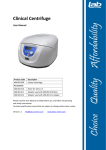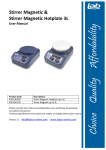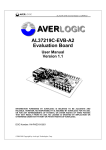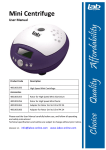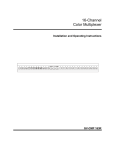Download User Manual
Transcript
Micro Centrifuge User Manual Product Code Description 400.003.005 Micro Centrifuge Accessories 400.003.010 Rotor Plastic for 0.2/0.5/1.5/2mL Tubes 400.003.011 Rotor Plastic for PCR Tubes 400.003.015 Adapter for Rotor 2mL to 0.2mL PK24 400.003.016 Adapter for Rotor 2ml to 0.5ml PK 24 Please read the User Manual carefully before use, and follow all operating and safety instructions! Technical specifications and outline are subject to change without prior notice. Version 1.1 [email protected] www.labco-online.com 1 Contents Page Number Introduction 3 Warranty 3 Delivery 3 Safety Reminder 4 Specification 7 Installation 7 Operation 8 Maintenance 9 2 Introduction Welcome to the Micro Centrifuge User Manual; Users should read this Manual carefully, follow the instructions and procedures, and beware of all the cautions when using this instrument. Warranty Warranty of the Centrifuge This centrifuge is guaranteed for 12 months from the date of delivery provided that it has been operated and maintained properly. Warranty of the Rotor Do not use the rotor once it has been corrosion or fatigue damage. We do not guarantee this centrifuge and the rotor under the following conditions even if within the guarantee period expires: (1) Failures caused by incorrect installation. (2) Failures caused by rough or improper handling. (3) Failures caused by conveyance or relocation after installation. (4) Failures caused by unauthorized disassembly or modification. (5) Failures caused by using parts of the other companies, such as rotors and adapters. (6) Failures caused by natural disasters including fire, earthquakes and so on. (7) Consumables and parts have a limited guarantee period Delivery This unit is supplied with one centrifuge unit, two rotors and user manual. 3 Safety Reminder Common safety precautions Carefully read the following safety precautions for a thorough understanding. Follow the instructions and procedures described in this manual to operate this centrifuge safely. Carefully read all safety messages in this manual and the safety instructions on the instrument. Safety messages are labelled as indicated below. They are in combination with signal words of “WARNING” and “CAUTION” with the safety alert symbol to call your attention to items or operations that could be dangerous to you or other persons using this instrument. The definitions of signal words are as follows: WARNING:Personal Danger Warning notes indicate any condition or practice, which if not strictly observed, could result in personal injury or possible death. CAUTION:Possible damage to instrument; Caution notes indicate any condition or practice, which if not strictly observed or remedied, could result in damage or destruction of the instrument. NOTE:Notes indicate an area or subject of special merit, emphasising either the product’s capability or common errors in operation or maintenance. Do not operate this centrifuge in any manner not described in this User manual. When in doubt or have any troubles with this centrifuge, ASK FOR HELP. The precautions described in this User manual are carefully developed in an attempt to cover all the possible risks. However, it is also important that you are alert for unexpected incidents. Be carefully operating this centrifuge. 4 WARNING: This centrifuge is not explosion-proof. Never use explosive or flammable samples. Do not install the centrifuge in or near places where inflammable gases are generated or chemicals are stored. Do not place dangerous material within 30cm around the centrifuge. Make sure to prepare necessary safety measures before using samples that are toxic, radioactive or contaminated with pathogenic micro-organisms at your own responsibility. If the instrument, rotor and/or accessories that has been contaminated by solutions with toxic, radioactive or pathogenic materials, clean it according to the decontamination procedure that you are specified. If you require services at site, please sterilise and decontaminate it in advance, and then notice the service centre involved in the details of the particular materials. Do not handle the power cord or turn on or off the POWER switch with wet hands to void electrical shocks. For safety purposes, do not enter within 30cm around this centrifuge while it is in operation. While the rotor is rotating, never forcedly release the door lock. Unauthorized repairs, disassembly, and other services to the centrifuge except by our service centre are strictly prohibited. 5 CAUTION This centrifuge must be located on one firm and level table. Make sure the centrifuge is horizontal before running. Make sure the angle between the door and cover is greater than 70 degrees when open the door. Be careful not to put your fingers or hands between the door and cover when the door is off. Do not move or relocate this centrifuge while it is running. When there is fluid in the rotor chamber, please promptly dry with a dry cloth to avoid sample contamination. Ensure to remove any objects and fragments of the tubes dropped inside the rotor chamber before running this centrifuge. Caution on rotors 1. Always check for corrosion and damages on the rotor surface before using it. Do not use the rotor if such abnormality found. 2. Do not set the centrifuge speed override the allowable minimum speed of the rotor kits (rotor or the other adapters). Make sure to run it below the allowable minimum speed. 3. Do not allowable imbalance. 4. Use the rotor and tubes within their actual capacities. 6 Specifications Maximum speed 7,000rpm Maximum RCF 2,680 x g Maximum capacity 2mL x 8 Timer Continuous operation Driving Motor DC motor Power Single-phase, 110V-240V, 50Hz/60Hz requirements Dimensions (D x W 155 x 150 x 117mm x H) Weight 6kgs500g Noise <45dB Installation This section describes the instructions that you should abide by when installing the centrifuge to ensure your safety and the optimum performance. Before moving the centrifuge, the rotor must be removed. WARNING: Incorrect power supply may damage centrifuge. Make sure the power source conforms to the required power supply before connecting. Location 1. 2. 3. 4. Locate this centrifuge on a firm, flat and level table; ensure the four feet of this centrifuge stand on the table firmly. Avoid installing on a slippery table-board that conveys vibration. Ideal ambient temperature is 20℃±5℃, avoid placing the centrifuge in direct sunlight if temperature exceeds 30℃. Keep clearances of at least 10cm on both sides of centrifuge and at least 30cm behind it to ensure its cooling efficiency. No heat or water resource nearby, otherwise easily cause sample temperature increase or centrifuge failures. 7 Connection of the power cord and grounding WARNING: Do not touch the power cord with wet hands to avoid electrical shocks. This centrifuge must be grounded properly. 1. This centrifuge is equipped with a 3P flat plug; grounding can be done just by plugging the 3P plug into the outlet. 2. A cover 10A outlet which has a good ground is required, and meets with local safety requirements. Operation Loading the Rotor Place the rotor into position on the motor shaft. Press the rotor down to secure the rotor with shaft. Please use your both hands to load the rotor. Operation Open the lid and switch on the on/off switch (located back of the unit.) Symmetrically load centrifuge tubes to rotor. Close the centrifuge lid to begin running. Switch off, the rotor will gradually stop. Open the lid and remove samples when the rotor has completely stopped. 8 Maintenance Not following the recommended instructions for cleaning or disinfecting may damage the centrifuge. (1) Centrifuge If the centrifuge is exposed to ultraviolet rays for a long time, the color of the doors may change and/or the label may come off. After using, cover the centrifuge with a piece of cloth to protect it from direct exposure. Once the centrifuge is heavily dirty, clean it with a cloth or sponge moistened with a neutral detergent solution. Sterilise the centrifuge by wiping with a cloth moistened with 70% ethanol solution. (2) Rotor chamber CAUTION:Do not directly pour water, neutral detergent or disinfectant solution into the rotor chamber. Otherwise fluids may leak into the drive units and cause corrosion or deterioration to the bearings. Once the rotor chamber is dirty, clean with cloth or sponge moistened with a neutral detergent solution. Sterilise the centrifuge by wiping with a cloth moistened with 70% ethanol solution. (3) Door Clean and sterilise the door using the same method as the step 1). (4) Rotor To prevent corrosion, remove the rotor from rotor chamber. If do not use regularly then detach the rotor door and flip the rotor to dry the tube holes. If a sample is leaked in the rotor, rinse the rotor with water. Apply a thin coat of silicon grease to the rotor when it is completely dried. The rotor should have regular maintenance, its recommended cleaning it each 3 months to ensure tube and rotor holes keep clean, and then apply a thin coat of silicon grease. 9 Page Left Intentionally Blank 10 Page Left Intentionally Blank 11 12












